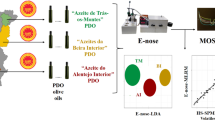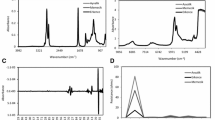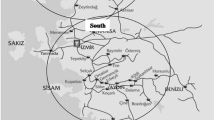Abstract
Among several parameters defined for the commercial classes of virgins olive oils (VOOs), there is one, the fatty acid ethyl ester (FAEE), that is only define for the best quality (EVOO). Fruit condition mainly determine these compounds, although, extraction process or deplorable storage condition could rise them up. The FAEE oxidation compound are originated by adding an alcohol chain into the oil molecule. Therefore, the hypothesis of this study is that the inherent constitution of FAEE entails a modification of the volatile profile of oils and olives and this is significant enough to be detected using an electronic nose. With this aim, different samples of olives and oils were analyzed in an accredited laboratory. On the other hand, volatiles from the same samples were captured by an electronic nose. The classification problem was analyzed from two points of view or models. The first was to classify fruits and oils based on whether they are within or outside the legal limits. And the second problem was oriented to classify fruits and oils based on their high or low FAEE content but being within the legal limits. To solve this problem, three classification algorithms were evaluated: Naïve Bayes (NB), Multilayer Perceptron (MLP) and Sequential Minimal Optimization (SMO). For the first model, a well-classified sample rate of 80.3% was obtained for NB and 100% for SMO and MLP, for measurements on oils. The same model evaluated with measurements on olives yielded a success rate of 87.5% with NB, 87.7% with MLP and 82.1% with SMO. For the second model, the success rates remained within the same orders of magnitude. For measurements on oils, the results were 89.7% for NB, 92.5% for MLP and 100% for SMO. And for measurements on olives the results were 77.9% for NB, 88.6% for MLP and 90.9% for SMO. In all cases, the characteristics that worked best were those obtained from the first derivative of the electronic nose response. Based on these results, the e-nose demonstrate to be a non-invasive technology suitable for the classification of olive fruits and oils based on their FAEE content.


Similar content being viewed by others
References
C. Cavallo, F. Caracciolo, G. Cicia, T. Del Giudice, Extra-virgin olive oil: are consumers provided with the sensory quality they want? A hedonic price model with sensory attributes. J Sci Food Agric 98(4), 1591–1598 (2018). https://doi.org/10.1002/jsfa.8633
G.D. Fernandes, A.C. Ellis, A. Gámbaro, D. Barrera-Arellano, Sensory evaluation of high-quality virgin olive oil: panel analysis versus consumer perception. Curr Opin Food Sci 21, 66–71 (2018). https://doi.org/10.1016/j.cofs.2018.06.001
M. Battino et al., Relevance of functional foods in the Mediterranean diet: the role of olive oil, berries and honey in the prevention of cancer and cardiovascular diseases. Crit Rev Food Sci Nutr 59(6), 893–920 (2019). https://doi.org/10.1080/10408398.2018.1526165
Á. Hernáez, J. Valussi, A. Pérez-Vega, O. Castañer, M. Fitó, Olive Oil and Health Effects, in Bioactive Molecules in Food. ed. by J.-M. Mérillon, K.G. Ramawat (Springer International Publishing, Cham, 2019), pp. 1071–1096
R. Ascrizzi et al., Nutraceutical oils produced by olives and citrus peel of Tuscany varieties as sources of functional ingredients. Molecules 24(1), 65 (2018). https://doi.org/10.3390/molecules24010065
C. Sanmartin et al., Cold-pressing olive oil in the presence of Cryomacerated leaves of Olea or citrus: nutraceutical and sensorial features. Molecules 24(14), 2625 (2019). https://doi.org/10.3390/molecules24142625
A. Asdagh, S. Pirsa, Bacterial and oxidative control of local butter with smart/active film based on pectin/nanoclay/Carum copticum essential oils/β-carotene. Int J Biol Macromol 165, 156–168 (2020). https://doi.org/10.1016/j.ijbiomac.2020.09.192
S. Srivastava, S. Sadistap, Data processing approaches and strategies for non-destructive fruits quality inspection and authentication: a review. J Food Meas Charact 12(4), 2758–2794 (2018). https://doi.org/10.1007/s11694-018-9893-2
P. Cano Marchal, D. Martínez Gila, J. Gámez García, J. Gómez Ortega, Optimal production planning for the virgin olive oil elaboration process. IFAC Proc 47(3), 8921–8926 (2014). https://doi.org/10.3182/20140824-6-ZA-1003.02203
J. Beltrán, D.M. Martínez Gila, D. Aguilera Puerto, J. Gámez García, J. Gómez Ortega, Novel technologies for monitoring the in-line quality of virgin olive oil during manufacturing and storage. J Sci Food Agric (2016). https://doi.org/10.1002/jsfa.7733
M. Grompone, N. Callejas, N. Martínez, C. Feller, M. Amarillo, B.A. Irigaray, Variation of the content of ethyl esters in extra virgin olive oils during their shelf life. J Food Sci Eng 6(1), 21–25 (2016). https://doi.org/10.17265/2159-5828/2016.01.003
S. Buratti, C. Malegori, S. Benedetti, P. Oliveri, G. Giovanelli, E-nose, e-tongue and e-eye for edible olive oil characterization and shelf life assessment: a powerful data fusion approach. Talanta (2018). https://doi.org/10.1016/j.talanta.2018.01.096
P. Boeker, On ‘Electronic Nose’ methodology. Sensors Actuators, B Chem 204, 2–17 (2014). https://doi.org/10.1016/j.snb.2014.07.087
N. Nimsuk, Improvement of accuracy in beer classification using transient features for electronic nose technology. J Food Meas Charact 13(1), 656–662 (2019). https://doi.org/10.1007/s11694-018-9978-y
H. Kavuncuoglu, T. Dursun Capar, S. Karaman, H. Yalcin, Oxidative stability of extra virgin olive oil blended with sesame seed oil during storage: an optimization study based on combined design methodology. J Food Meas Charact 11(1), 173–183 (2017). https://doi.org/10.1007/s11694-016-9384-2
J. Jin, S. Deng, X. Ying, X. Ye, T. Lu, G. Hui, Study of herbal tea beverage discrimination method using electronic nose. J. Food Meas Charact 9(1), 52–60 (2014). https://doi.org/10.1007/s11694-014-9209-0
Z. Haddi et al., Discrimination and identification of geographical origin virgin olive oil by an e-nose based on MOS sensors and pattern recognition techniques. Procedia Eng 25, 1137–1140 (2011). https://doi.org/10.1016/j.proeng.2011.12.280
D. Melucci et al., Rapid direct analysis to discriminate geographic origin of extra virgin olive oils by flash gas chromatography electronic nose and chemometrics. Food Chem 204, 263–273 (2016). https://doi.org/10.1016/j.foodchem.2016.02.131
A.R. Di Rosa, F. Leone, C. Scattareggia, V. Chiofalo, Botanical origin identification of Sicilian honeys based on artificial senses and multi-sensor data fusion. Eur Food Res Technol 244(1), 117–125 (2018). https://doi.org/10.1007/s00217-017-2945-8
Q. Li, X. Yu, L. Xu, J.M. Gao, Novel method for the producing area identification of Zhongning Goji berries by electronic nose. Food Chem 221, 1113–1119 (2017). https://doi.org/10.1016/j.foodchem.2016.11.049
H. Wu, T. Yue, Y. Yuan, Authenticity tracing of apples according to variety and geographical origin based on electronic nose and electronic tongue. Food Anal Methods 11(2), 522–532 (2018). https://doi.org/10.1007/s12161-017-1023-y
M.E. Escuderos, M. García, A. Jiménez, M.C. Horrillo, Edible and non-edible olive oils discrimination by the application of a sensory olfactory system based on tin dioxide sensors. Food Chem 136(3–4), 1154–1159 (2013). https://doi.org/10.1016/j.foodchem.2012.09.051
S. Pirsa, F.M. Nejad, Simultaneous analysis of some volatile compounds in food samples by array gas sensors based on polypyrrole nano-composites. Sens Rev 37(2), 155–164 (2017). https://doi.org/10.1108/SR-10-2016-0217
A. Loutfi, S. Coradeschi, G.K. Mani, P. Shankar, J.B.B. Rayappan, Electronic noses for food quality: a review. J Food Eng 144, 103–111 (2015). https://doi.org/10.1016/j.jfoodeng.2014.07.019
J. Beltran Ortega, J. Gamez García, J. Gómez Ortega, Precision of volatile compound analysis in extra virgin olive oil: The influence of MOS electronic nose acquisition factors. IEEE Int Conf Ind Technol (ICIT) (2015). https://doi.org/10.1109/ICIT.2015.7125306
X. Ying, A. Zinnai, F. Venturi, C. Sanmartin, S. Deng, Freshness evaluation of grass carp (Ctenopharyngodon idellus) by electronic nose. J Food Meas Charact (2017). https://doi.org/10.1007/s11694-017-9478-5
T. Majchrzak, W. Wojnowski, T. Dymerski, J. Gębicki, J. Namieśnik, Electronic noses in classification and quality control of edible oils: a review. Food Chem (2018). https://doi.org/10.1016/j.foodchem.2017.11.013
European Commission 1991 European Commission Regulation 2568/91 on the characteristics of olive oil and olive-residue oil and on the relevant methods of analysis, and subsequent amendments., vol. L248., pp. 1–102.
E. Commission, Commission Regulation (EU) No 61/2011 of 24 January 2011 amending Regulation (EEC) No 2568/91 on the characteristics of olive oil and olive-residue oil and on the relevant methods of analysis. Off J Eur Union 2, 1–14 (2011)
European Commission, “COMMISSION IMPLEMENTING REGULATION (EU) No 1348/2013 of 16 December 2013 amending Regulation (EEC) No 2568/91 on the characteristics of olive oil and olive-residue oil and on the relevant methods of analysis,” Off. J. Eur. Union, vol. 2013, no. L338, pp. 31–67, 2013, [Online]. Available: http://faolex.fao.org/cgi-bin/faolex.exe?rec_id=032212&database=FAOLEX&search_type=link&table=result&lang=eng&format_name=@ERALL.
L. Conte et al., Olive oil quality and authenticity: a review of current EU legislation, standards, relevant methods of analyses, their drawbacks and recommendations for the future. Trends Food Sci Technol (2019). https://doi.org/10.1016/j.tifs.2019.02.025
M. Baietto, A.D. Wilson, Electronic-nose applications for fruit identification, ripeness and quality grading. Sensors 15(1), 899–931 (2015)
H.G.J. Voss, S.L. Stevan, R.A. Ayub, Peach growth cycle monitoring using an electronic nose. Comput Electron Agric 163, 104858 (2019). https://doi.org/10.1016/J.COMPAG.2019.104858
S. Sironi, L. Capelli, and N. Kishimoto, “Identification of Specific Odour Markers in Oil from Diseased Olive Fruits Using an Electronic Nose,” in CHEMICAL ENGINEERING TRANSACTIONS, 2018, vol. 68, Accessed: Oct. 29, 2018. [Online]. Available: www.aidic.it/cet.
J. P. Navarro Soto, D. M. Martínez Gila, E. Artero Vázquez, J. Gómez Ortega, and J. Gámez García 2019 “Sistema basado en nariz electrónica aplicada sobre aceituna para la determinación de la calidad del aceite de oliva producido,” XIX Simp. Científico-Técnico EXPOLIVA 2019, no. IND-25
S. Circi, D. Capitani, A. Randazzo, C. Ingallina, L. Mannina, A.P. Sobolev, Panel test and chemical analyses of commercial olive oils: a comparative study. Chem Biol Technol Agric 4(1), 1–10 (2017). https://doi.org/10.1186/s40538-017-0101-0
IOC 2018 “International Trade Standard Applying To Olive Oils and Olive-Pomace Oils International Trade Standard Applying To Olive Oils and Olive-Pomace Oils,” COI/T.15/NC, no. No3/REV.12, pp. 1–17
S. Pirsa, Ş Tağı, M. Rezaei, Detection of authentication of milk by nanostructure conducting polypyrrole-ZnO. J Electron Mater 50(6), 3406–3414 (2021). https://doi.org/10.1007/s11664-021-08855-2
S. Pirsa, E. Banafshechin, S. Amiri, A. Rahimirad, J. Ghafarzadeh, Detection of fraud of palm, sunflower, and corn oil in butter using HPLC profile of tocopherols and tocotrienols by response surface method. J Iran Chem Soc 18(5), 1167–1177 (2021). https://doi.org/10.1007/s13738-020-02100-z
M. Alizadeh, S. Pirsa, N. Faraji, Determination of lemon juice adulteration by analysis of gas chromatography profile of volatile organic compounds extracted with nano-sized polyester-polyaniline fiber. Food Anal Methods 10(6), 2092–2101 (2017). https://doi.org/10.1007/s12161-016-0747-4
F. Angerosa, Influence of volatile compounds on virgin olive oil quality evaluated by analytical approaches and sensor panels. Eur J Lipid Sci Technol 104(9–10), 639–660 (2002). https://doi.org/10.1002/1438-9312(200210)104:9/10%3c639::AID-EJLT639%3e3.0.CO;2-U
International Olive Council, “COI/T.20/Doc. no 22.” 2005.
D.M. Martínez Gila, J. Gámez García, A. Bellincontro, F. Mencarelli, J. Gómez Ortega, Fast tool based on electronic nose to predict olive fruit quality after harvest. Postharvest Biol Technol (2019). https://doi.org/10.1016/j.postharvbio.2019.111058
P. Cano Marchal, C. Sanmartin, S. Satorres Martínez, J. Gómez Ortega, F. Mencarelli, J. Gamez García, Prediction of fruity aroma intensity and defect presence in virgin olive oil using an electronic nose. Sensors 21(7), 1–17 (2021). https://doi.org/10.3390/s21072298
G.G. Teixeira et al., Application of a lab-made electronic nose for extra virgin olive oils commercial classification according to the perceived fruitiness intensity. Talanta (2021). https://doi.org/10.1016/J.TALANTA.2021.122122
European Commission 2016 “Commission Delegated Regulation (EU) 2016/2095 amending Regulation (EEC) No 2568/91 on the characteristics of olive oil and olive-residue oil and on the relevant methods of analysis,” Off. J. Eur. Union 326: 1–6
M.L. Clodoveo, R.H. Hbaieb, F. Kotti, G.S. Mugnozza, M. Gargouri, Mechanical strategies to increase nutritional and sensory quality of virgin olive oil by modulating the endogenous enzyme activities. Compr Rev Food Sci Food Saf 13(2), 135–154 (2014). https://doi.org/10.1111/1541-4337.12054
G. Beltran, R. Sánchez, A. Sánchez-Ortiz, M.P. Aguilera, M.A. Bejaoui, A. Jimenez, How ‘ground-picked’ olive fruits affect virgin olive oil ethanol content, ethyl esters and quality. J Sci Food Agric 96(11), 3801–3806 (2016). https://doi.org/10.1002/jsfa.7573
P. Masella, L. Guerrini, G. Angeloni, B. Zanoni, A. Parenti, Ethanol from olive paste during malaxation, exploratory experiments. Eur J Lipid Sci Technol (2019). https://doi.org/10.1002/ejlt.201800238
M.D.C. Pérez-Camino, A. Cert, A. Romero-Segura, R. Cert-Trujillo, W. Moreda, Alkyl esters of fatty acids a useful tool to detect soft deodorized olive oils. J Agric Food Chem 56(15), 6740–6744 (2008). https://doi.org/10.1021/jf801131b
R.B. Gómez-Coca, G.D. Fernandes, M. del C. Pérez-Camino, and W. Moreda, , Fatty acid ethyl esters (FAEE) in extra virgin olive oil: a case study of a quality parameter. LWT - Food Sci Technol (2016). https://doi.org/10.1016/j.lwt.2015.10.063
L. García-Vico, A. Belaj, L. León, R. de la Rosa, C. Sanz, A.G. Pérez, A survey of ethanol content in virgin olive oil. Food Control (2018). https://doi.org/10.1016/j.foodcont.2018.04.006
H. Karami, M. Rasekh, E. Mirzaee-Ghaleh, Qualitative analysis of edible oil oxidation using an olfactory machine. J Food Meas Charact 14(5), 2600–2610 (2020). https://doi.org/10.1007/s11694-020-00506-0
J. Navarro Soto, S. Satorres Martínez, D. Martínez Gila, J. Gómez Ortega, J. Gámez García, Fast and reliable determination of virgin olive oil quality by fruit inspection using computer vision. Sensors (2018). https://doi.org/10.3390/s18113826
G. Squeo, R. Silletti, C. Summo, V.M. Paradiso, A. Pasqualone, F. Caponio, Fatty acids methyl and ethyl esters behaviour during olives processing. Ital J Food Sci 29, 370–376 (2017)
G. H. John and P. Langley, “Estimating Continuous Distributions in Bayesian Classifiers,” Feb. 2013, Accessed: Jan. 21, 2019. [Online]. Available: http://arxiv.org/abs/1302.4964.
R.O. Duda, P.E. Peter, E. Hart, D.G. Stork, Pattern Classification (Wiley, 2001)
B. Jimenez, A. Sánchez-Ortiz, M.L. Lorenzo, A. Rivas, “Effect of agronomical practices on the nutritional quality of virgin olive oil at different ripening stages”, JAOCS. J Am Oil Chem Soc 92(10), 1491–1501 (2015). https://doi.org/10.1007/s11746-015-2710-8
S. Alcalá et al., Alkyl esters content and other quality parameters in oil mill: A response surface methodology study. Eur J Lipid Sci Technol (2017). https://doi.org/10.1002/ejlt.201600026
Acknowledgements
This work has been partially supported by the project of the Ministry of Spain with reference PID2019-110291RB-I00. The authors thank the oil mill Picualia (www. piculia.com) for the olive samples provided to carry out this study. Also we are very thankful for the financial support provided by the Spanish Ministry of Economy and Competitiveness (Precommercial public procurement Innolivar) Exp. 2018/00001, co-funded by European FEDER funds, and the financial support provided by the Interprofessional Organization of Table Olive and Olive Oil, Spain https://interaceituna.com/.
Author information
Authors and Affiliations
Corresponding author
Additional information
Publisher's Note
Springer Nature remains neutral with regard to jurisdictional claims in published maps and institutional affiliations.
Rights and permissions
About this article
Cite this article
Martínez Gila, D.M., Sanmartin, C., Navarro Soto, J. et al. Classification of olive fruits and oils based on their fatty acid ethyl esters content using electronic nose technology. Food Measure 15, 5427–5438 (2021). https://doi.org/10.1007/s11694-021-01103-5
Received:
Accepted:
Published:
Issue Date:
DOI: https://doi.org/10.1007/s11694-021-01103-5




